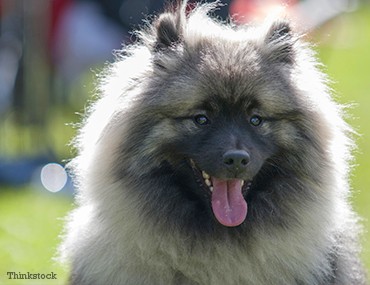Background
The Keeshond—national dog of the Netherlands—shares blood ties with the Samoyed, Chow Chow, Norwegian Elkhound, Finnish Spitz, and the Pomeranian. He once worked as a watchdog on riverboats and on family farms. The Kees became highly popular in the 1700s and a mascot for the Dutch Patriot political party. The party’s leader, Kees de Gyselaer, is credited with naming the breed after his own dog.
The Keeshond was recognized by the American Kennel Club in 1930.
Sizing up
- Weight: 35 to 45 lbs.
- Height: 17 to 18 inches
- Coat: Double, long, harsh
- Color: Any variations of black, silver, gray, cream, tawny, and white
- Life expectancy: 12 to 15 years
What’s the Keeshond like?
The Keeshond is a happy, loving, playful pooch. He will want to spend plenty of time with his family and is great with kids. He likes to stay active but only requires a moderate amount of exercise; a nice walk or a game of fetch will make him happy. Due to his size, the Kees is highly adaptable to many living conditions. However, he is a barker and likely to put security ahead of your neighbors sleeping needs.
The Keeshond is a smart dog but he has a stubborn side. You should train him at a young age and be firm and consistent. Keep sessions quick and engaging because he does tend to get bored easily. With patience, treats, and praise you’ll have a well trained dog!
At first glance it may seem like grooming a Keeshond would be time consuming, but it’s easily manageable if you give him a good brushing about twice a week.
Because of how long his coat is he can be sensitive to the heat and shouldn’t be left outdoors without shade.
Health
The Keeshond is typically a healthy breed but potential conditions include:
Hip dysplasia
- One of the most common diseases seen in dogs. It is ultimately a malfunction of the hip joints resulting in a loss of function
- A knee condition where one or both kneecaps can accidentally slip out of place
- A condition of repetitive seizures
- A disease caused by a decrease in metabolism due to an under-active thyroid hormone
Hyperparathyroidism
- A medical condition that occurs when a tumor in the parathyroid gland produces an excessive level of parathyroid hormones that lead to an increased blood calcium level
Progressive retinal atrophy
- An eye condition that worsens over time and could lead to loss of vision
Renal cortical hypoplasia
- A disease where the protective layer of the kidneys is poorly developed, which over time leads to renal failure
Tetralogy of fallot
- A genetic disease involving four abnormalities of the heart. Keeshonds are subject to this disease so you should consider getting records of your dog's parents to see if this could become a factor
Mitral valve insufficiency
- A condition that occurs when the mitral valve of the heart weakens, and can no longer close properly, causing blood to leak back into the left atrium which can lead to heart failure
Addison’s disease
Takeaway points
The Keeshond makes a great watchdog.
The Keeshond is good with children.
The Keeshond can overheat if left outdoors in the sun.
The Keeshond would be suitable to many living quarters.
If you have any questions or concerns, you should always visit or call your veterinarian -- they are your best resource to ensure the health and well-being of your pets.
